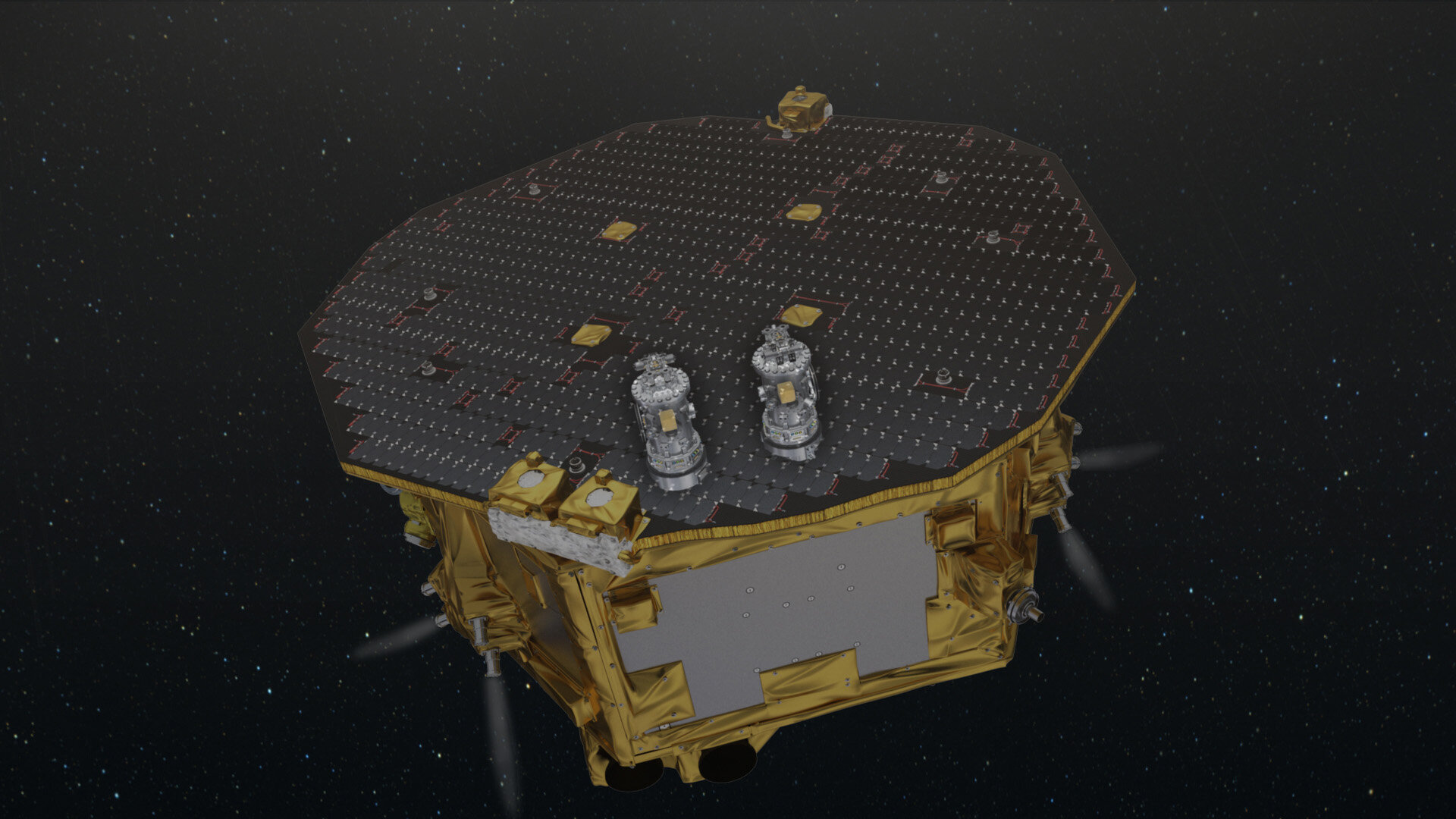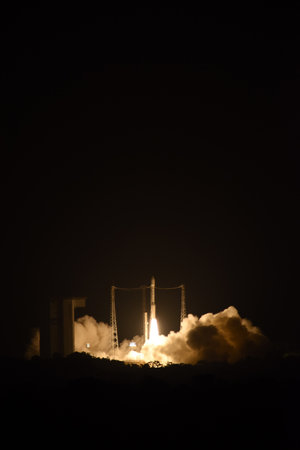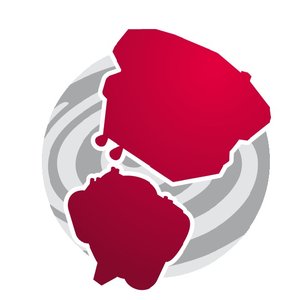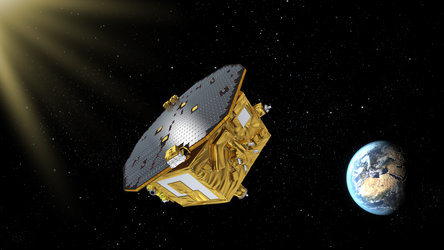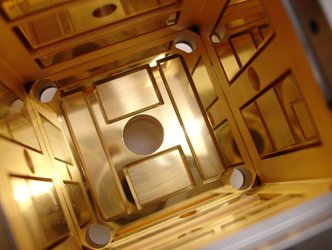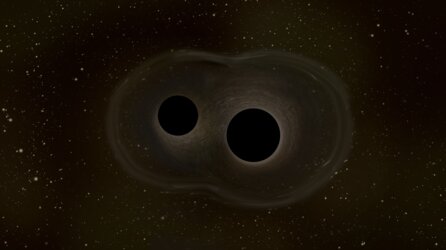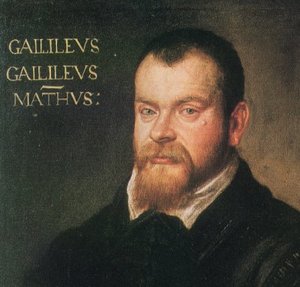LISA Pathfinder Completes First Operations Phase
On Saturday 25 June, the LISA Technology Package (LTP) – a European payload on ESA's LISA Pathfinder – completed its nominal operations phase, passing the baton to the Disturbance Reduction System, an additional experiment provided by NASA. This won't be the last time the European experiment is run – the recently approved mission extension will see the LTP back in action for seven months starting in November this year.
After over three months of outstanding scientific experiments, the first operations phase of the LISA Pathfinder mission came to an end. The conclusion of this part of the mission happened at 10:00 CEST (08:00 UTC) on Saturday, 25 June 2016.
Launched on 3 December 2015, LISA Pathfinder is a technology demonstrator, testing instruments and methods to observe gravitational waves – fluctuations in the fabric of spacetime – from space.
The spacecraft reached its operational orbit around the Lagrange point L1 – 1.5 million km away from Earth towards the Sun – at the end of January and, following a number of crucial milestones during the commissioning phase, the science mission began on 1 March.
At the core of the spacecraft are two test masses – a pair of identical gold-platinum cubes, measuring 46 mm and with a mass of 2 kg each. As recently announced, the mission reached, and very soon exceeded, its goal: placing the two test masses in the most precise freefall ever.
This was achieved by measuring the position and orientation of the test masses – whose motion is continually perturbed by external and internal forces – with a laser interferometer, and by subsequently manoeuvring the spacecraft around them to be constantly centred on one of the cubes, shielding the test masses without touching them.

The team's first results, based on just two months of operations, show that the mission has already obtained a control on the test masses comparable to that needed to build a future space-borne observatory of gravitational waves. A paper reporting the results is published in Physical Review Letters.
"During the last few weeks, we improved the performance even further than detailed in the paper," says Paul McNamara, LISA Pathfinder Project Scientist at ESA. "We couldn't be happier about the mission's outcome."
Until today, the spacecraft has been adjusting its position using several sets of cold-gas thrusters that are applied on three of the outer panels of the science module and are capable of applying forces of 1–100 micronewtons. The cold-gas thrusters work in tandem with the LISA Technology Package (LTP), the mission's core payload, which was developed by ESA and several institutes, industry and space agencies from ESA member states.
This first phase in the mission comprised about 100 days of operations, as well as 15 days dedicated to station-keeping manoeuvres – these correct the spacecraft orbit once every one to two weeks.

Starting yesterday, 26 June, the mission is running the Disturbance Reduction System (DRS) payload, a separate experiment contributed by the US. This experiment received measurement input from the test masses and interferometer that are part of the LTP, but it's using now its own drag-free control software and two clusters of micronewton thrusters, mounted on two opposite panels of the science module, to control the position and attitude of the spacecraft.
Based on colloidal micronewton thrusters, which generate propulsion by charging small drops of liquid and accelerating them through an electric field, the DRS experiment contributes to the mission by validating additional technology for future drag-free spacecraft.
After two weeks of commissioning, the operations phase of the DRS will last until the end of October. The LTP team will return for one week in early August to continue the long-term monitoring of their experiment and to facilitate some cross-calibration with the DRS experiment.
An extended mission, approved by ESA's Science Programme Committee at their 21-22 June meeting, will begin on 1 November, for seven months. During this period the team will further investigate the performance of the LTP at low frequencies – of particular interest in the context of a future space-based gravitational-wave observatory – as well as testing some experimental operational modes.
"Although we won't be working with our LISA Technology Package for most of the next few months while the Disturbance Reduction System experiment is running, we do have plenty of excellent data that we'll be examining in great detail," says Paul. "But there's no doubt that we'll be looking forward to seeing how far we can go with LISA Pathfinder when we start the extended mission later this year."
NOTES FOR EDITORS
LISA Pathfinder is an ESA mission with important contributions from its member states and NASA.
The LISA Technology Package payload has been delivered by several national funding agencies and ESA, in particular: Italy (ASI); Germany (DLR); the United Kingdom (UKSA); France (CNES); Spain (CDTI); Switzerland (SSO); and the Netherlands (SRON). LISA Pathfinder also carries the Disturbance Reduction System payload, provided by NASA.
FOR FURTHER INFORMATION, PLEASE CONTACT:
Paul McNamara
LISA Pathfinder Project Scientist
Scientific Support Office
Directorate of Science
European Space Agency
Phone: +31 71 565 8239
Email: paul.mcnamara@esa.int















 Germany
Germany
 Austria
Austria
 Belgium
Belgium
 Denmark
Denmark
 Spain
Spain
 Estonia
Estonia
 Finland
Finland
 France
France
 Greece
Greece
 Hungary
Hungary
 Ireland
Ireland
 Italy
Italy
 Luxembourg
Luxembourg
 Norway
Norway
 The Netherlands
The Netherlands
 Poland
Poland
 Portugal
Portugal
 Czechia
Czechia
 Romania
Romania
 United Kingdom
United Kingdom
 Slovenia
Slovenia
 Sweden
Sweden
 Switzerland
Switzerland


























